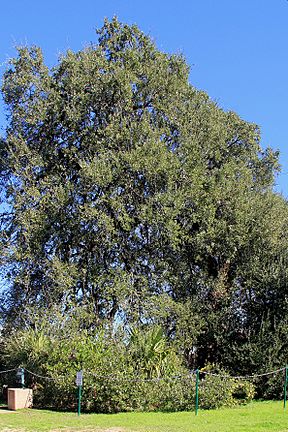Treaty Oak (Austin, Texas) facts for kids
Quick facts for kids Treaty Oak |
|
|---|---|

The Treaty Oak in 2015
|
|
| Species | Texas live oak (Quercus fusiformis) |
| Location | West Line Historic District, Austin, Texas |
| Coordinates | 30°16′17″N 97°45′20″W / 30.27130°N 97.75550°W |
The Treaty Oak is a very old and special Texas live oak tree. It stands in Austin, Texas, United States. This tree is the last one left from a group of 14 trees called the Council Oaks. Long ago, these trees were a sacred meeting place. Comanche and Tonkawa tribes used to gather there.
Experts believe the Treaty Oak is about 500 years old. Before it was damaged in 1989, its branches spread out very wide. They covered an area of about 127 feet (39 m). You can find the Treaty Oak in Treaty Oak Park. This park is on Baylor Street in Austin's West Line Historic District.
Contents
What Makes the Treaty Oak Special?
The Treaty Oak has a rich history. It is also surrounded by many interesting stories. These tales connect the tree to Native American tribes and early Texas settlers.
Ancient Stories of the Council Oaks
Native American legends say the Council Oaks were important. They were used to plan both war and peace gatherings. Another story tells of women from the Tejas tribe. They would drink a special tea made from honey and acorns. This tea was believed to keep their warriors safe in battle.
Folklore and Famous Texans
Local stories suggest that Stephen F. Austin met Native Americans here. This meeting was supposedly to sign Texas's first boundary treaty. This happened after some people were hurt in raids. However, there are no old documents to prove this meeting actually took place.
Another popular tale says Sam Houston rested under the Treaty Oak. This was after he left his job as Governor of Texas. This happened when Texas was getting involved in the American Civil War.
How the Treaty Oak Was Saved
Over time, as more people moved to Texas, the Council Oaks disappeared. By 1927, only one of the original 14 trees was left. This tree was the Treaty Oak. The American Forestry Association recognized it as a perfect example of a North American tree. They even put it in their Hall of Fame.
Buying the Land for the Tree
In the 1880s, the Caldwell family owned the land where the tree stood. In 1926, Mrs. Caldwell could not afford the property taxes. She offered to sell the land. Local history groups wanted the Texas Legislature to buy it. But no money was set aside for this. Finally, in 1937, the City of Austin bought the land. They paid $1,000 for it. They also put up a plaque to honor the tree's role in Texas history.
The Attack on the Treaty Oak
In 1989, someone deliberately harmed the Treaty Oak. They poisoned it with a strong plant killer called Velpar. Lab tests showed enough poison was used to kill 100 trees. This act made the community very angry. News about it was shared across the country. Children even made "Get Well" cards for the tree. These cards were displayed on the fence around the park.
Helping the Tree Recover
Many people worked hard to save the Treaty Oak. A Texas businessman named Ross Perot offered to pay for all the efforts. DuPont, the company that made the poison, offered a reward. This reward was for information to find the person who did it. The person responsible, Paul Cullen, was caught. He was found guilty of damaging the tree.
To save the tree, workers put sugar around its roots. They also replaced the soil and sprayed the tree with spring water. Even though experts thought the tree would die, the Treaty Oak survived! Still, almost two-thirds of the tree died. More than half of its top branches had to be cut off.
The Treaty Oak Today
In 1997, the Treaty Oak produced its first acorns since the poisoning. City workers collected these acorns. They grew them into new tree seedlings. These young trees were then sent all over Texas and other states.
Today, the Treaty Oak is still growing strong. It looks a bit lopsided, but it is a powerful reminder of its past. Many Texans see the Treaty Oak as a symbol of strength and never giving up. In 2009, tree experts from the International Society of Arboriculture worked with Austin's Parks Department. They helped trim and care for the Treaty Oak.
Images for kids
- Treaty Oak from the Handbook of Texas Online


